Ripening tomatoes at home, harvesting rules and storage methods
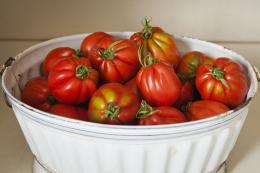
The need to speed up the ripening of tomatoes at home arises with a sharp drop in temperature and heavy rains in August. Under such conditions, normal ripening of tomatoes becomes impossible, since with systematic rainfall the tomatoes can be destroyed by late blight.
Content:
- Rules for collecting tomatoes for ripening
- How to properly pick green tomatoes
- Is it possible to ripen tomatoes at home?
- Ways to ripen tomatoes at home
- How to speed up the ripening of picked tomatoes
Rules for collecting tomatoes for ripening
When collecting, it is important to pay attention to color tomato and its size, depending on which the level of its ripeness differs.
So, there are three types of coloring:
- Red, orange or pink, depending on the variety - ripe;
- Blanzhevye (yellowish-red color);
- Green both in color and in essence.
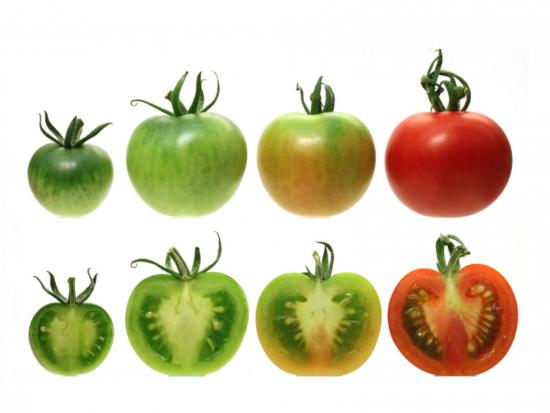
If the fruit has already grown to a fixed varietal size, and seeds can be seen in the cut, it can be picked.
Tomatoes that are too small should not be touched; they will not ripen at home.
In addition to size, it is recommended to pay attention to the condition of the tomato. Thus, it is strictly forbidden to send damaged ones for ripening. The rot and disease that affects them can spread to the rest and completely destroy the entire harvest.
Proper selection is the key to a successful outcome of the entire event.If the green fruits are ready in all respects and have no visible damage, they are suitable for picking.
How to properly pick green tomatoes
Before moving on to the question of how to turn green tomatoes red, it is worth paying attention to one more aspect. It is important not only to follow the rules for selecting tomatoes for harvesting, but also to correctly separate them from the bush.
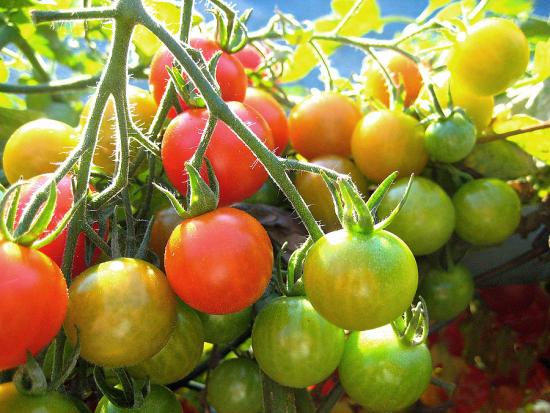
This is what is recommended:
- Pick tomatoes as they ripen, checking the bushes every three to five days. You should not delay this, since overripe tomatoes are not suitable for long-term storage, they are only suitable for direct consumption;
- Collection is best done in the morning in dry weather. The fruit should be removed together with the stalk, cutting it with sharp scissors. When harvesting, it is important not to accidentally cut the skin, as this can lead to subsequent rotting, which will destroy not only the damaged tomato, but also those in the immediate vicinity;
- After harvesting, be sure to sort through the fruits again and check for damage and disease. Even a small scratch and foulbrood should be rejected;
- To prevent the formation of late blight, it is recommended to immerse already selected fruits in hot water for a few minutes, then wipe thoroughly. High temperature will help destroy spores of pathogenic fungus that could get on the skin.
It is important to remember that all tomatoes must be harvested before nighttime temperatures begin to drop below five degrees.
If it was not possible to harvest before the first frost, such fruits are suitable only for immediate consumption; they are not suitable for ripening and storage.
Is it possible to ripen tomatoes at home?
Ripening tomatoes at home is a possible and widespread practice. Previously, in order for green fruits to ripen, they were placed in felt boots and sent to a warm and dark place. And now they still use this method, replacing felt boots with a warm wool scarf or jacket, but there are also more modern methods that are worth paying attention to.
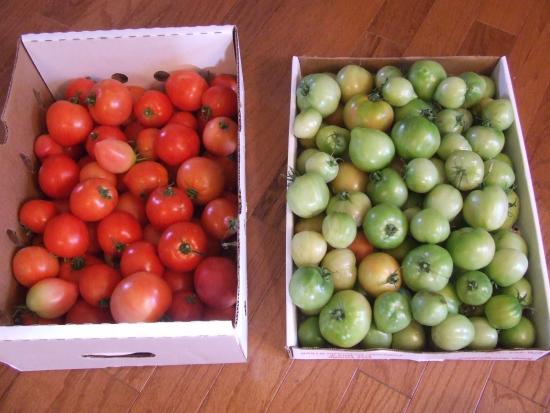
In addition, tomatoes, along with apples, are sometimes placed in a pan or paper bag. The fruits leave behind and the ethylene released by apples activates the ripening processes.
The main thing is that, when wondering how to store tomatoes so that they ripen, do not come to the decision of placing them in plastic or a refrigerator. This prevents the flow of oxygen and can provoke the development of mold and rot.
Let's watch a video on how to slow down and speed up the ripening of tomatoes:
Ways to ripen tomatoes at home
From the methods proposed in the table, you can choose any one that is most suitable for your conditions.
| Stacked | This option is suitable for large plantations. Bushes cut at the root are stacked so that the tops are located towards the center. The height of the stack should not exceed sixty centimeters, it is recommended to insulate it with straw mats, the maintained temperature should not be less than 15 C. The stack is checked every two days. |
| On the bushes | This method requires a large, warm room where you need to hang the dug up bushes. You need to place the roots on top so that the nutrients go to the top, thereby provoking increased redness of the tomatoes. If hanging is not possible, the bushes can be buried indoors, systematically moistening the root. |
| Traditional | After picking the tomatoes, they are placed in baskets or boxes in several layers. It is important to consider where to place the tomatoes to ripen, since a room that is too cold or damp can ruin the crop. To prevent this from happening, it is better to place the fruits sprinkled with sawdust and placed in boxes in a dark, warm place. To prevent tomatoes from starting to rot, it is important to systematically check them and remove those that turn red. |
For a small farm, the traditional method is quite suitable. The method of activating ripening on stacks and bushes is recommended for large volumes of harvest.
How to speed up the ripening of picked tomatoes
There are many options for speeding up the ripening of picked tomatoes. One of the best ways is to place it in a warm place, and if these are fruits of the blanzhe type, also in the light. The best place for them is the window sills of southern windows.
However, it is important to remember that to arrange in one place tomatoes Blange tapa and green ones are not worth it. A pre-sorted crop will be more effective.
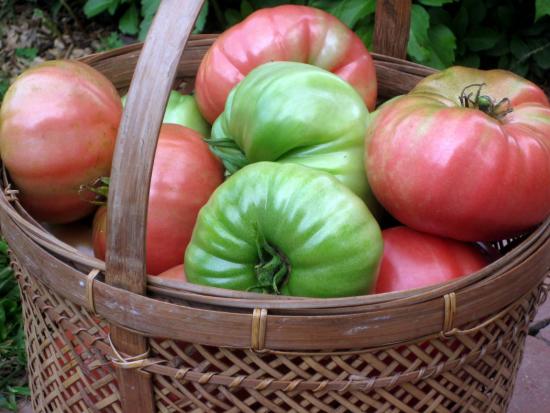
After the tomatoes are laid out, you can:
- Place some ripe apples in one container with green tomatoes - red ones. The ethylene they release activates the ripening processes;
- Inject 0.5 ml of alcohol into each fruit using a regular syringe. It is better to inject in the area of the stalk to minimize damage to the skin;
- Cover green fruits with a red cloth; according to many experienced gardeners, the red color promotes rapid ripening.
These methods will help speed up the ripening process of the harvested crop. When selecting, it is important to consider that all fruits should be approximately the same size and ripeness.
Damaged and diseased tomatoes are not suitable for any of the artificial ripening methods.
Ripening tomatoes at home is not only a common, but also a very important practice. In the case of cool summers or harsh climatic conditions, only this helps preserve the harvest.
And some more useful tips, watch the video:

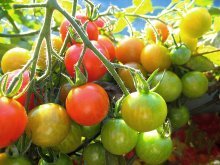
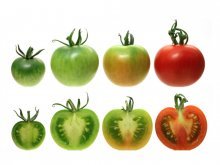
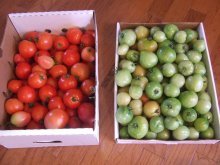
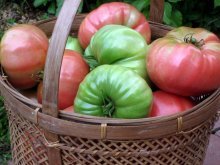
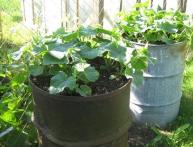
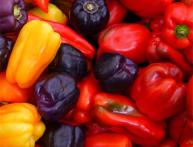
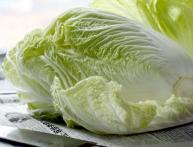


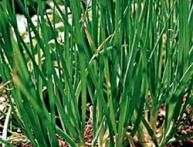
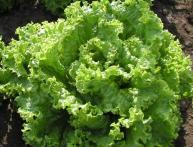
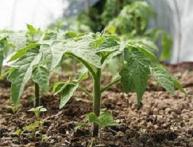
Comments
I will definitely use the recommendations from the article, since unripe tomatoes have remained on the bush for several years now. I managed to save the ones that were whitish in color, but they didn’t last long after that and they deteriorated.
It’s unlikely that anyone pours boiling water over harvested tomatoes; there is a fear that they will lose their pleasant smell and taste that they have. But it’s best when the tomatoes are picked already ripe.
How then can children or drivers eat alcohol-preserved tomatoes? Or can this method only be used for those tomatoes that will be used for preparation? I’ll probably continue to keep the tomatoes in the drawer under the bed; we love to eat them “alive.”
Every year I pick green tomatoes from the bush. I store it in simple wooden boxes, covered with something warm. They ripen quickly and smoothly; no red rag, much less alcohol, is needed.
If there is no sawdust, you can arrange the tomatoes with newspapers; some gardeners in our area use felt boots along with boxes. And so every autumn my dacha and apartment are filled with boxes of ripening tomatoes; they simply don’t have time to reach the condition on the bush. By the way, some of the green tomatoes can be rolled into jars.
On the northern slope, late blight always doesn’t have time to ripen on the bush... We have to remove it earlier. I can tell you from experience: tomatoes that have already ripened in the house are better suited for packing. They are stronger and juicier or something... But in terms of taste...To be honest, not really. My opinion: if possible, it is still better for them to ripen on the bush